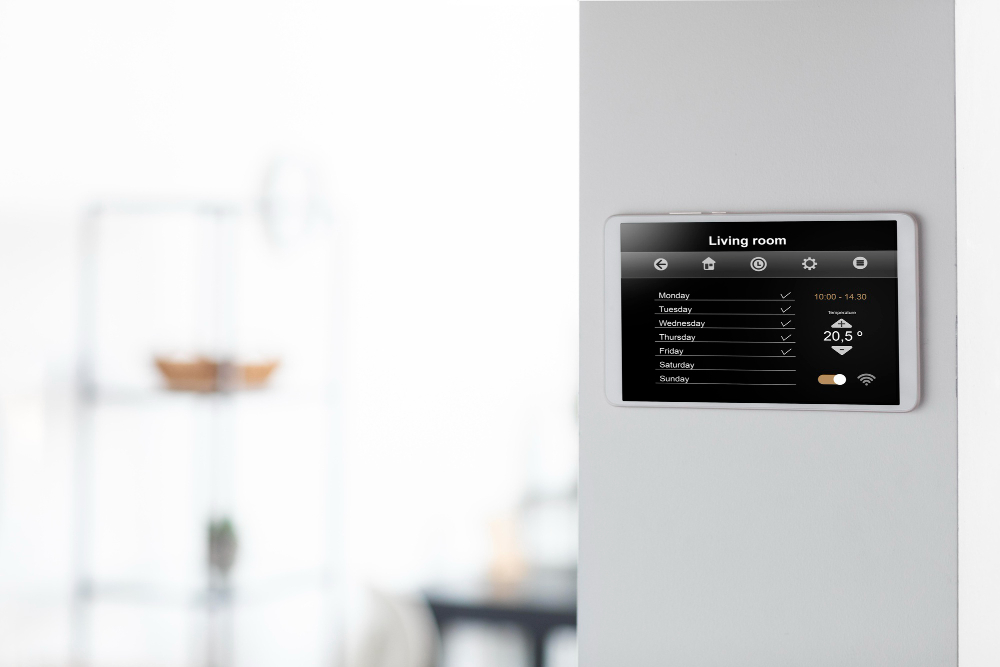Imagine walking into a room that is always the perfect temperature, as if the environment adapted to your comfort. Now, picture having complete control over your home’s heating and cooling systems even when you’re miles away. It’s not a sci-fi fantasy anymore; it’s the reality that smart thermostats can offer.
This innovation has revolutionized the way we interact with home heating and promises substantial savings on energy bills.
Smart thermostats have allowed homeowners to save both money and the planet. But Is it worth the investment? And how does it work, anyway?
In this comprehensive guide, we’ll talk about any myths, break down the benefits, and guide you through enhancing the comfort and efficiency of your home with a smart thermostat.
Table of Contents
Understanding Smart Thermostats
To put it simply, a smart thermostat is a device that allows you to control your home’s heating and cooling systems remotely, usually through an app on your smartphone or tablet. It uses advanced technology such as sensors, Wi-Fi connectivity, and machine learning algorithms to learn your preferences and adjust the temperature accordingly.
Unlike traditional thermostats, which require manual adjustments, smart thermostats can automatically adapt to your habits and surroundings. They can also be controlled through voice commands, making it even more convenient for users.
The Cost-Saving Benefits
One of the most significant advantages of upgrading to a smart thermostat is the potential cost savings on energy bills. By optimizing heating and cooling settings based on your behavior and schedule, these devices can significantly reduce energy consumption, resulting in lower utility bills.
According to the American Council for Energy Efficient Economy, smart thermostats have been proven to reduce HVAC energy consumption, providing homeowners with savings of 8% in heating costs and 10% in cooling costs.
Additionally, some energy companies offer rebates or discounts for installing a smart thermostat, making it even more cost-effective.
Other Advantages
Aside from saving money, smart thermostats offer other benefits, including:
- Increased comfort: With the ability to adjust temperature settings remotely and automatically, you can ensure that your home is always comfortable.
- Environmental impact: By reducing energy consumption, smart thermostats also positively impact the environment by decreasing greenhouse gas emissions.
- Remote access: Did you forget to remember to turn off the AC before leaving for vacation? No problem. With a smart thermostat, you can control your home’s temperature from anywhere in the world, right from your phone.
- Maintenance alerts: Smart thermostats can also send alerts when it’s time to change air filters or schedule maintenance for your HVAC system, ensuring optimal efficiency and prolonging its lifespan.
How Much Are They?
The cost of a smart thermostat varies depending on the brand and features, but they typically range from $100 to $250. However, the national average is around $420.
In addition to that though, you’ll need to pay for installation. But don’t let that discourage you; the long-term cost savings and benefits outweigh the initial investment. For installation, you can expect to pay somewhere between $200 – $500.
This will of course vary depending on where you live. For example, a local HVAC company in Alabama may charge $175 compared to a company in California that would charge $350.
While this might seem like a steep price for a thermostat, the potential savings on energy bills can quickly make up for the initial investment.
Furthermore, smart thermostats are designed to last longer than traditional thermostats and can even increase the value of your home. So, in the long run, it’s a worthwhile investment.
Is It Worth It?
The answer is yes. Upgrading to a smart thermostat can save you money on your energy bills, increase your home’s comfort, and positively impact the environment.
Plus, with technological advancements and increased accessibility, they are more affordable than ever. It’s a small change that can make a big difference.
Featured Image by freepik




